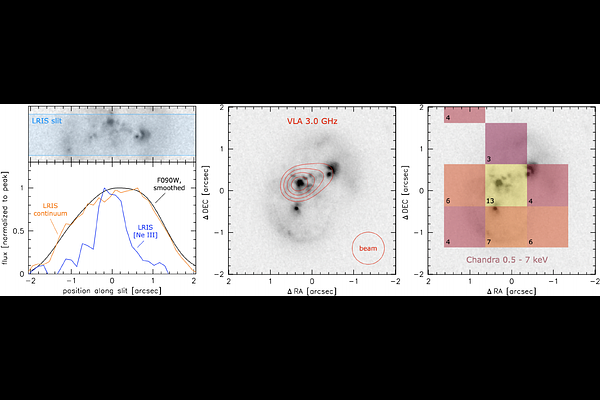The Infinity Galaxy: a Candidate Direct-Collapse Supermassive Black Hole Between Two Massive, Ringed Nuclei

The Infinity Galaxy: a Candidate Direct-Collapse Supermassive Black Hole Between Two Massive, Ringed Nuclei
Pieter van Dokkum, Gabriel Brammer, Josephine F. W. Baggen, Michael A. Keim, Priyamvada Natarajan, Imad Pasha
AbstractWe report the discovery of an unusual z=1.14 object, dubbed the $\infty$ galaxy, in JWST imaging of the COSMOS field. Its rest-frame near-IR light is dominated by two compact nuclei with stellar masses of $\sim 10^{11}$ Msun and a projected separation of 10 kpc. Both nuclei have a prominent ring or shell around them, giving the galaxy the appearance of a figure eight or an $\infty$ symbol. The morphology resembles that of the nearby system II Hz 4, where the head-on collision of two galaxies with parallel disks led to the formation of collisional rings around both of their bulges. Keck spectroscopy, VLA radio data, and Chandra X-ray data show that the $\infty$ galaxy hosts an actively accreting supermassive black hole (SMBH), with quasar-like radio and X-ray luminosity. Remarkably, the SMBH is not associated with either of the two nuclei, but is in between them in both position and radial velocity. Furthermore, from excess emission in the NIRCAM F150W filter we infer that the SMBH is embedded in an extended distribution of H$\alpha$-emitting gas, with a rest-frame equivalent width ranging from 400 - 2000 Angstrom. The gas spans the entire width of the system and was likely shocked and compressed at the collision site, in a galaxy-scale equivalent of what happened in the bullet cluster. We suggest that the SMBH formed within this gas in the immediate aftermath of the collision, when it was dense and highly turbulent. If corroborated with simulations and follow-up JWST spectroscopy, this would demonstrate that `direct' SMBH formation by a runaway gravitational collapse is possible in extreme conditions.